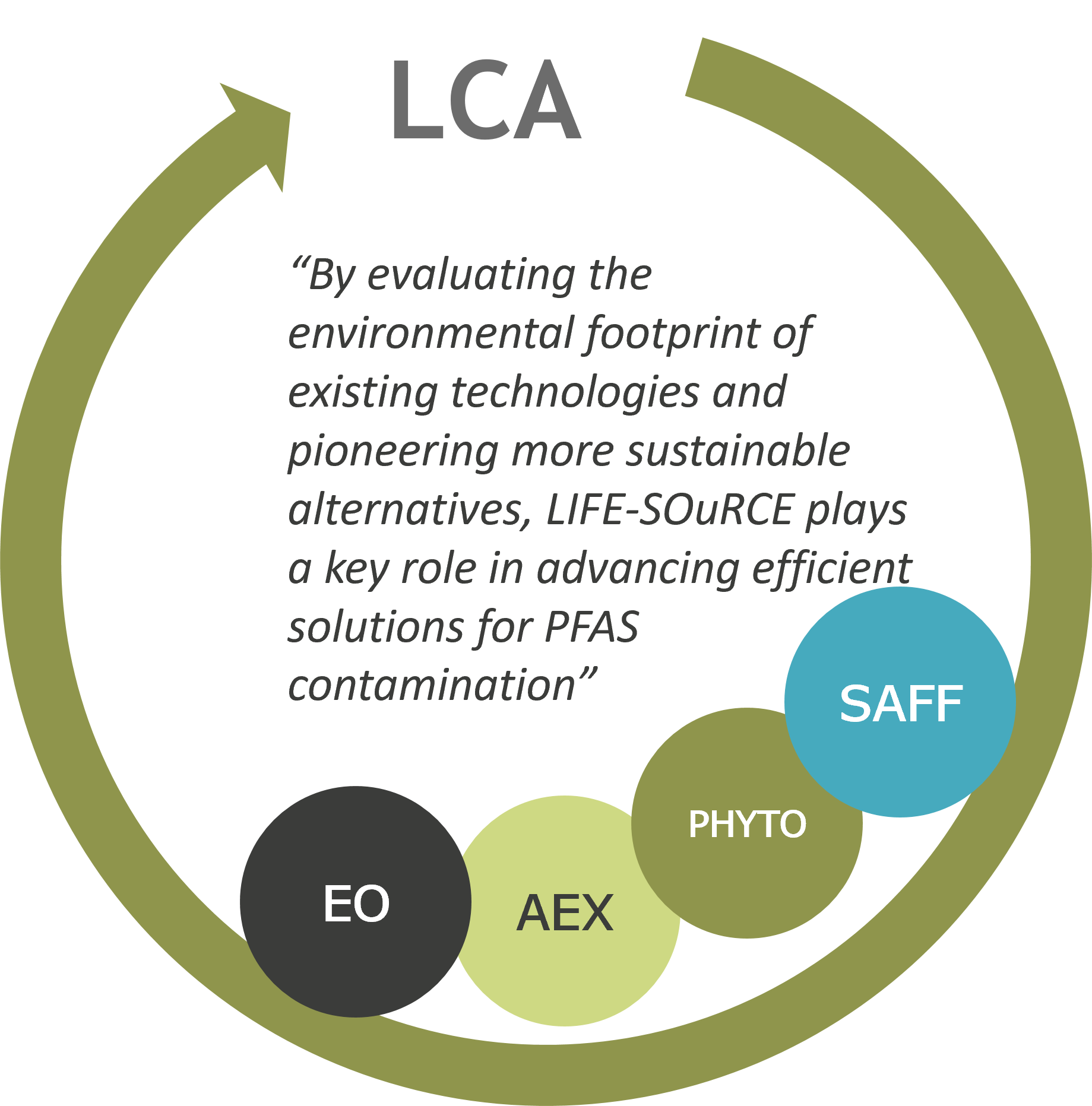Life Cycle Assessment (LCA) is a method for evaluating the environmental impact of a product (or service) throughout its life cycle, from the extraction of natural resources to final waste disposal after it is no longer used. In the LIFE-SOuRCE project, we are applying LCA to evaluate different technologies that can be used to treat groundwater contaminated with PFAS (per- and polyfluoroalkyl substances). Using LCA, the environmental impacts of a treatment technology throughout its life cycle, from material production to final waste disposal, can be assessed and different technologies can be compared with each other to identify technologies with the lowest possible environmental impact.
Common PFAS removal technologies for treating PFAS-contaminated water include granular activated carbon (GAC), ion exchange resins, and reverse osmosis. However, their application in groundwater treatment remains limited, highlighting the need for more sustainable alternatives.
The LIFE-SOuRCE project addresses this challenge by developing solutions that not only remove PFAS but also minimize their release and ensure safe waste management. The proposed technologies include Surface-Active Foam Fractionation (SAFF), Anion Exchange Filters (AEX), Electrochemical Oxidation (EO), and Phytoremediation (PHYTO). These methods are tested in treatment trains for PFAS-contaminated groundwater at demonstration sites in Spain and Sweden. The project aims to offer a cost-effective, versatile, and innovative remediation solution while reducing environmental impacts compared to traditional technologies like GAC.

LCA of PFAS Remediation
Previous studies have shown limitations in applying LCA to PFAS remediation due to the lack of primary data on material and energy use in commercial-scale projects. A recent analysis by the Swedish Geotechnical Institute highlights these limitations, noting that “none of the articles published to date were based on primary data on material and energy use from commercial-scale PFAS remediation projects.” The authors identified challenges such as the lack of high-quality background datasets and the need to assess and integrate site-specific primary environmental impacts.
LIFE-SOuRCE aims to bridge this gap by analyzing its technologies in real-world conditions. The LCA methodology follows ISO 14040:2006 and ISO 14044:2006 standards, with the functional unit defined as the remediation of 1 m³ of treated groundwater until a reduction in PFAS contamination is achieved, allowing it to be released back into the environment.
This approach adopts a cradle-to-grave scope, meaning it will assess the environmental impacts from the initial production of materials through to the final disposal of waste. The environmental impact categories were selected based on an extensive literature review about groundwater treatment polluted with PFAS and the Product Category Rules for Wastewater Treatment developed by Envirodec. The included categories are:
- global warming,
- ozone formation (human health),
- fine particulate matter formation,
- terrestrial acidification,
- freshwater eutrophication,
- mineral resource scarcity,
- fossil resource scarcity, and
- water consumption.
The life cycle inventory was created using data from the Spain and Sweden Pilot LIFE-SOuRCE project as well as the Ecoinvent database (v3). Primary data were obtained from experimental analyses on samples from the pilot sites, while energy consumption and capital goods information were collected on-site.
Comparative analysis with GAC – baseline scenario
At present, a comparative analysis with GAC, a commercial technology for treatment of PFAS contaminated water is conducted, considering factors such as the performance required, the type of groundwater to be treated, etc. For groundwater treatment by GAC adopting a cradle-to-grave scope, processes such as electricity production, steel manufacturing, GAC manufacturing (together with its reactivation), and incineration of GAC residues are considered. For this baseline scenario inventory, secondary data are used.
The results from this comparative analysis will provide essential insights for stakeholders, guiding them toward adopting more sustainable and efficient technologies.
Future Perspectives
As PFAS treatment technologies evolve, LCA will play an increasingly pivotal role in identifying key life cycle stages and assessing impacts such as energy consumption, greenhouse gas emissions, and cost-effectiveness. Future studies will refine this analysis, providing a deeper understanding of the remediation technologies’ overall environmental impacts. These insights will provide a strong foundation for more sustainable decision-making.
The LIFE-SOuRCE project exemplifies how innovative remediation technologies can reduce environmental impacts while demonstrating the importance of integrating LCA into development. By evaluating the environmental footprint of existing technologies and pioneering more sustainable alternatives, LIFE-SOuRCE plays a key role in advancing efficient solutions for PFAS contamination.
Implementing LCA in PFAS remediation fosters sustainability in current technologies and drives the development of next-generation solutions, which are essential for addressing PFAS contamination, protecting ecosystems, and safeguarding public health.

